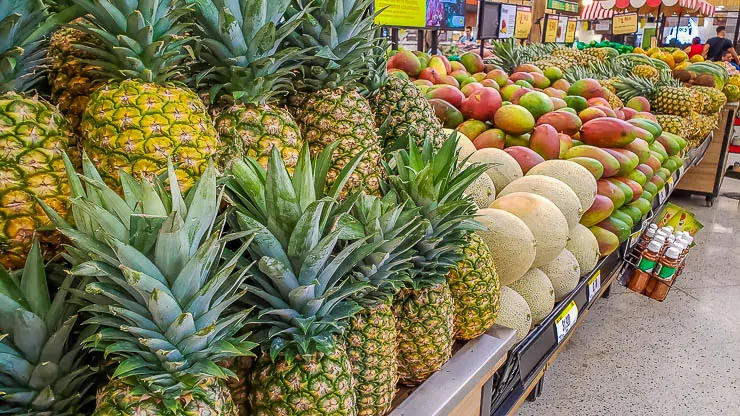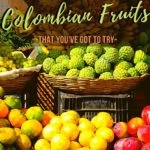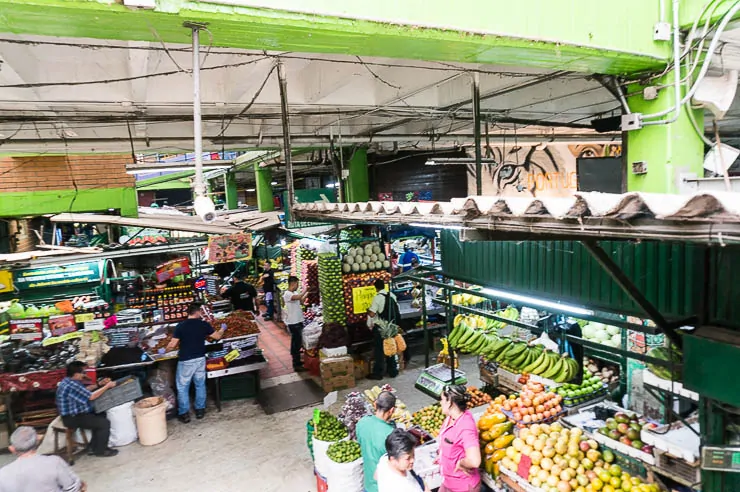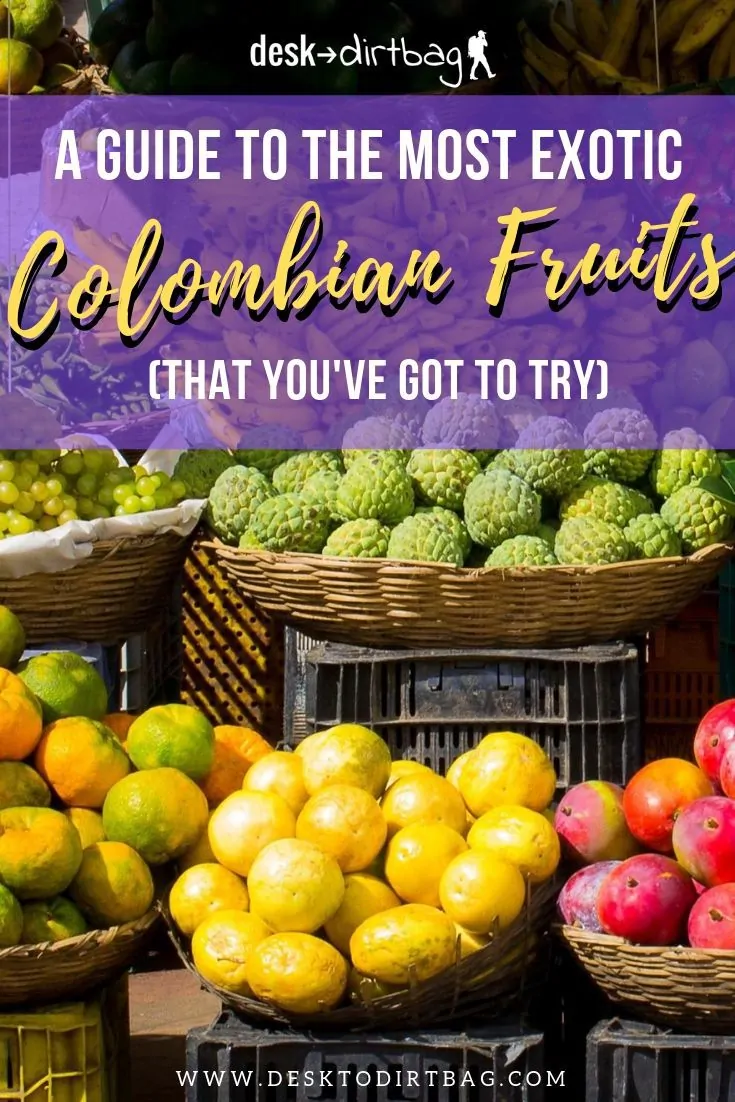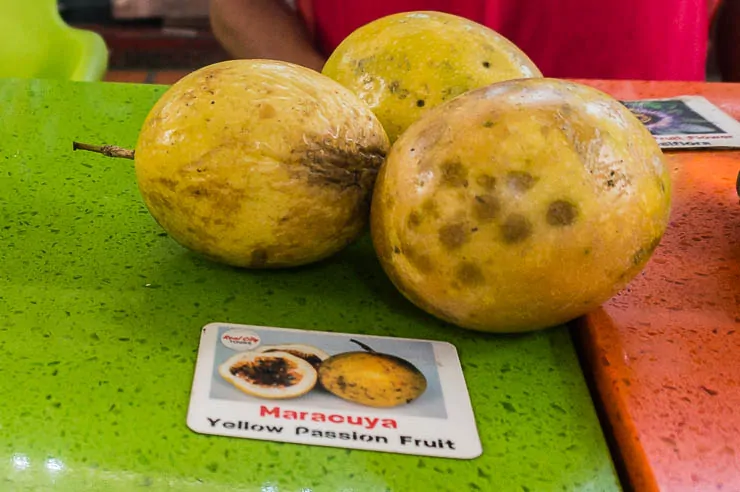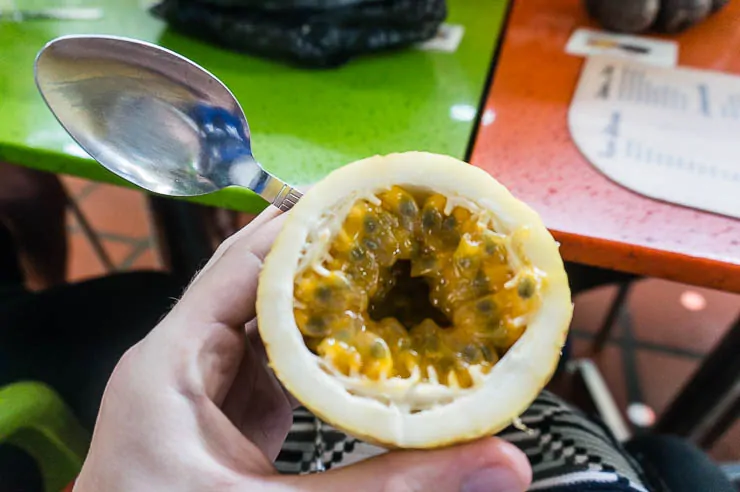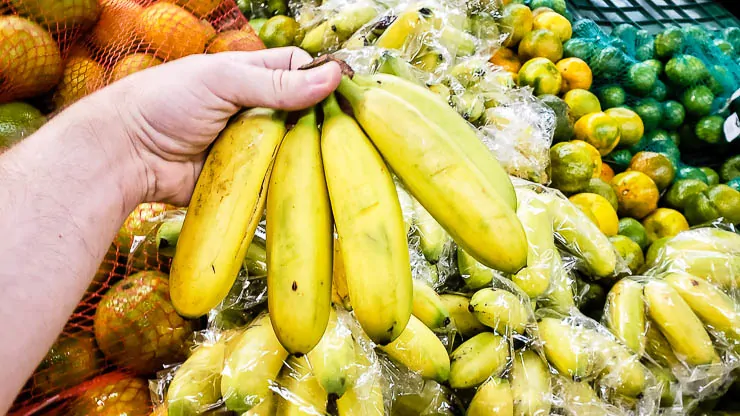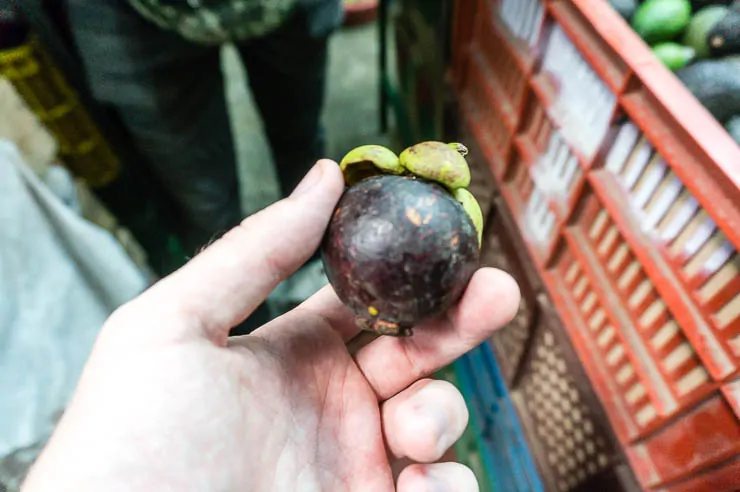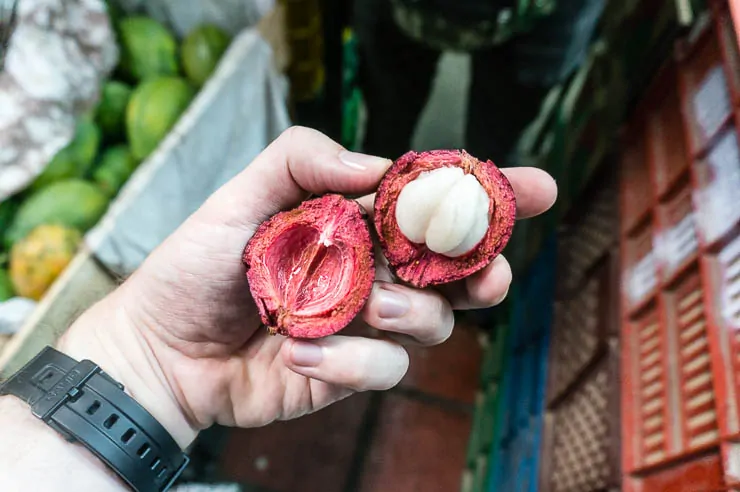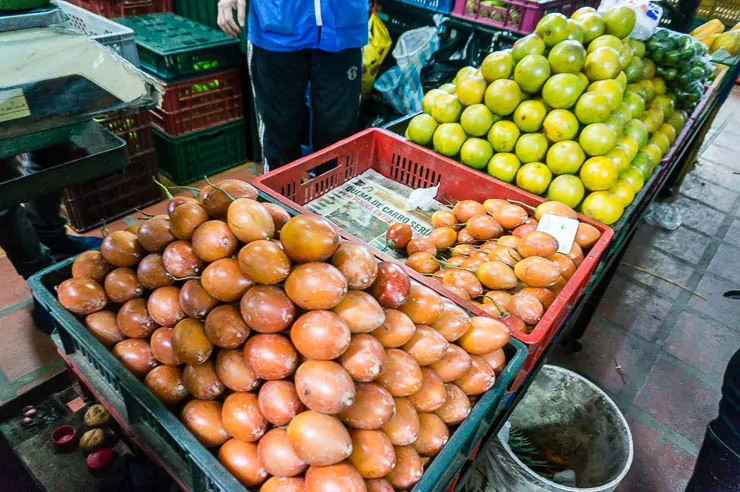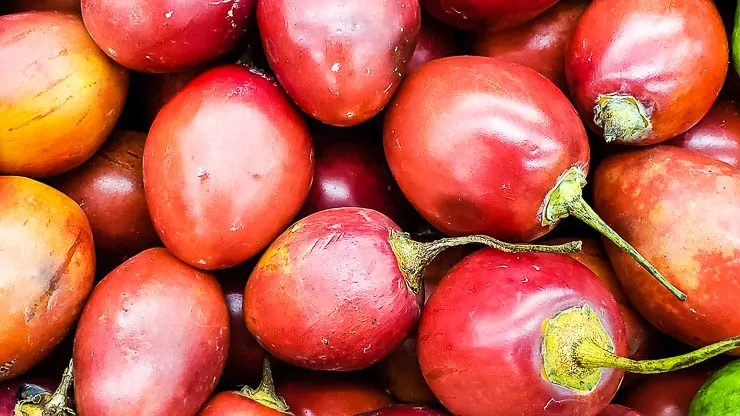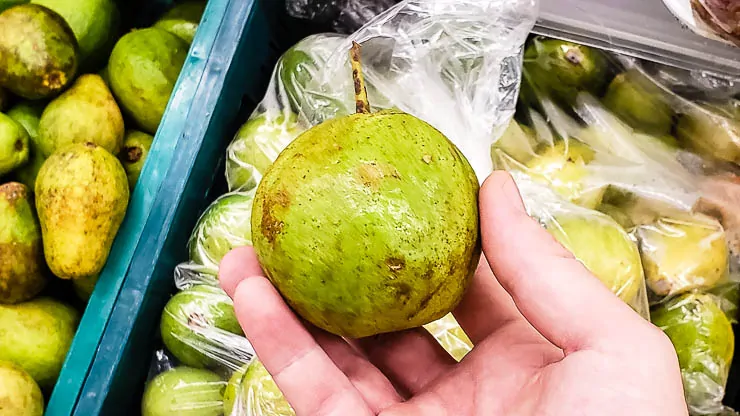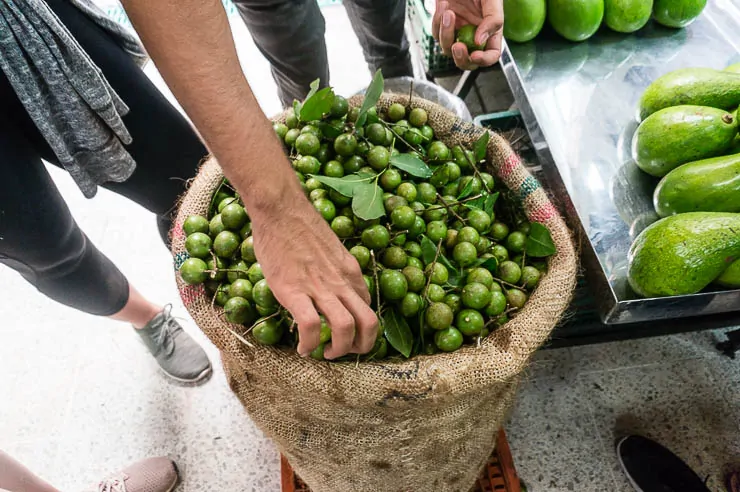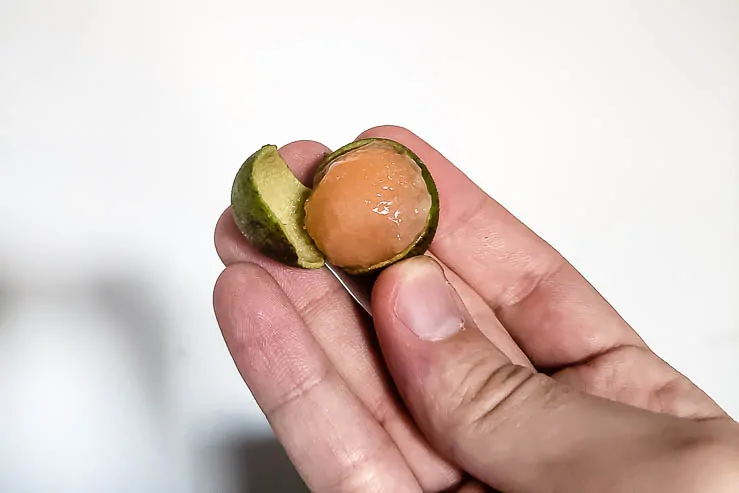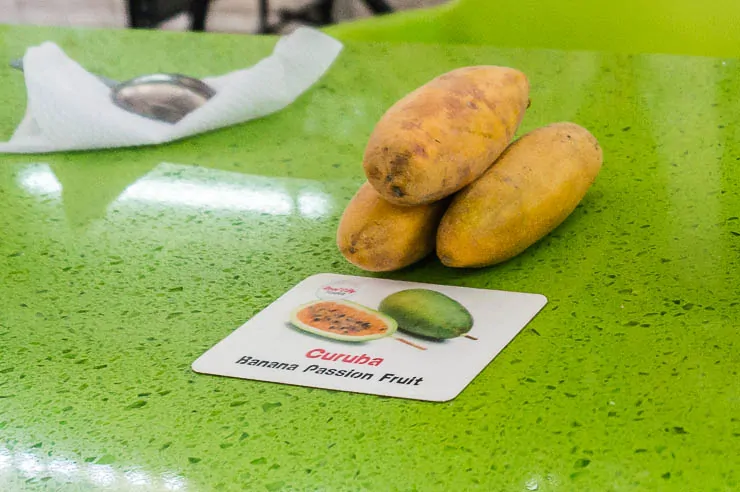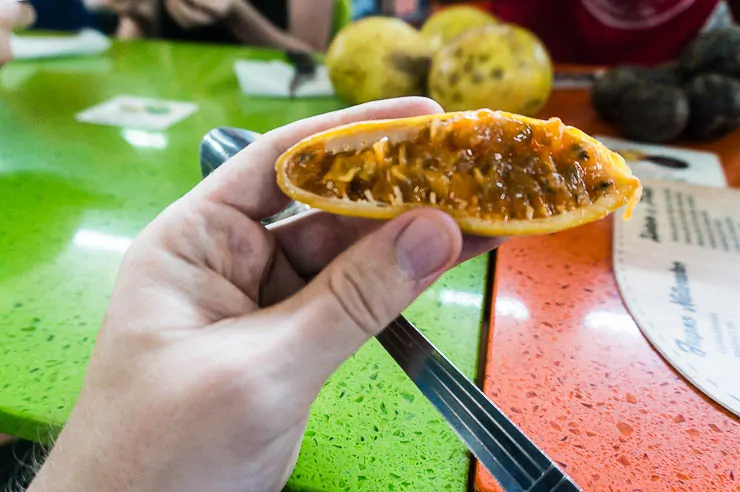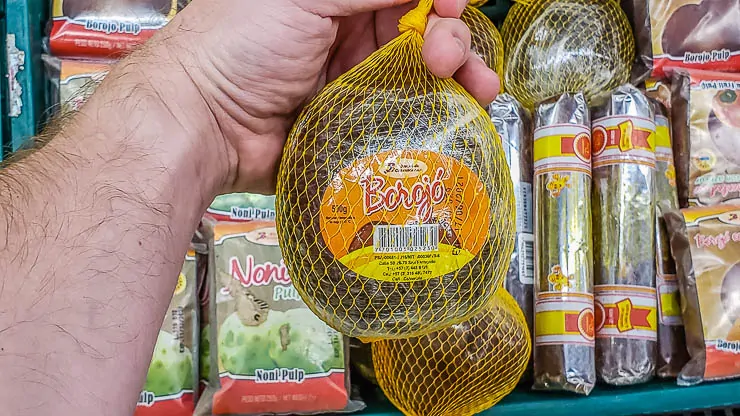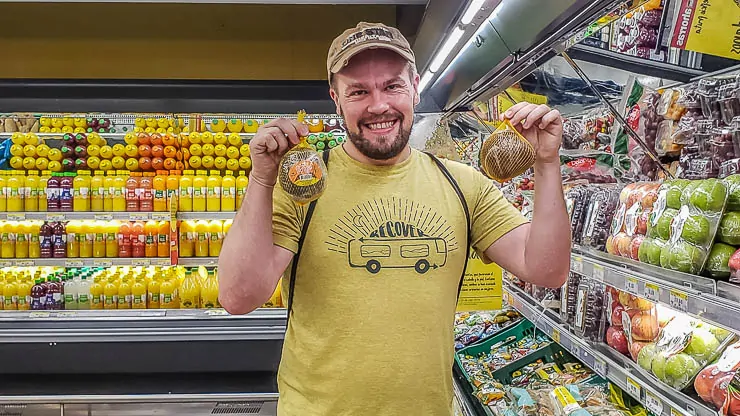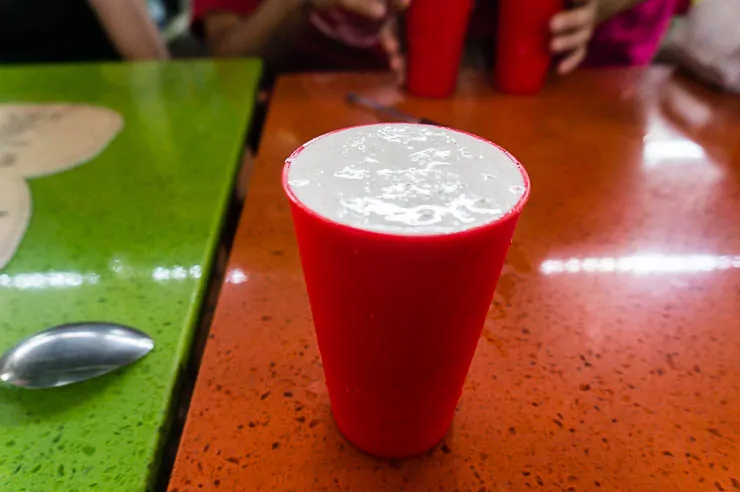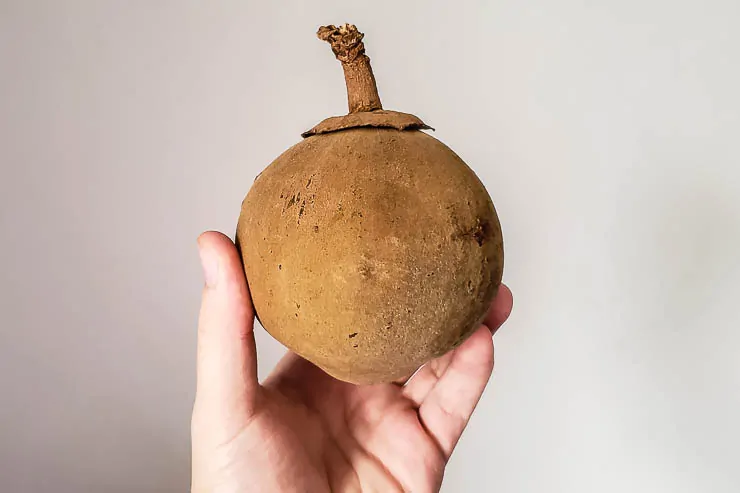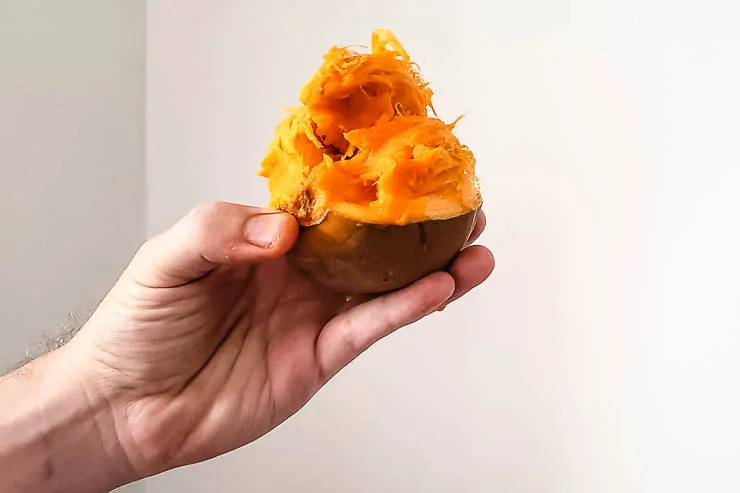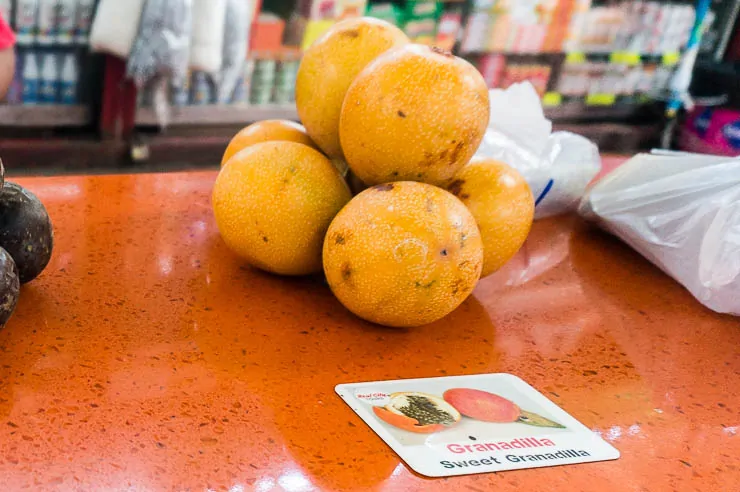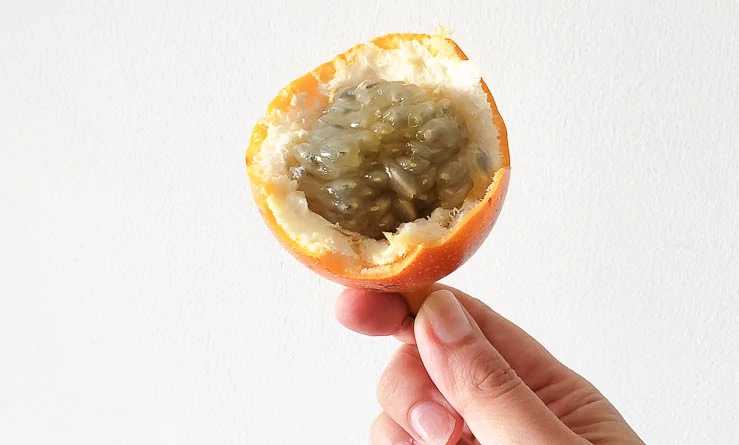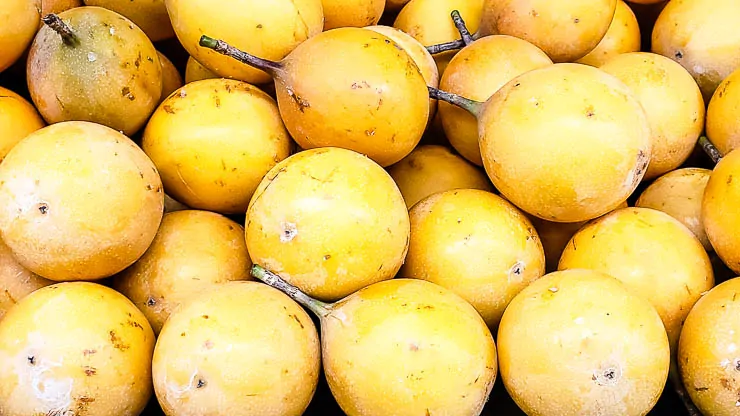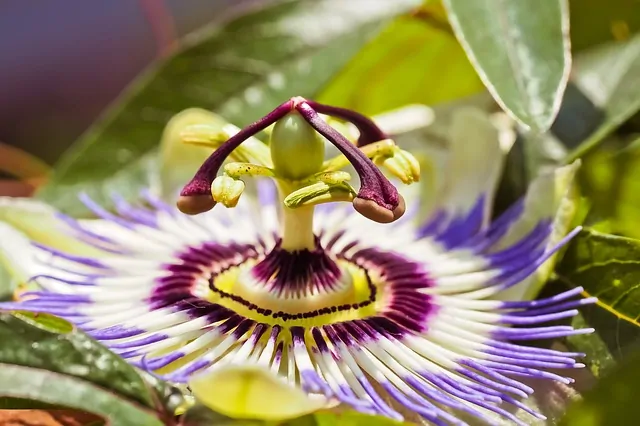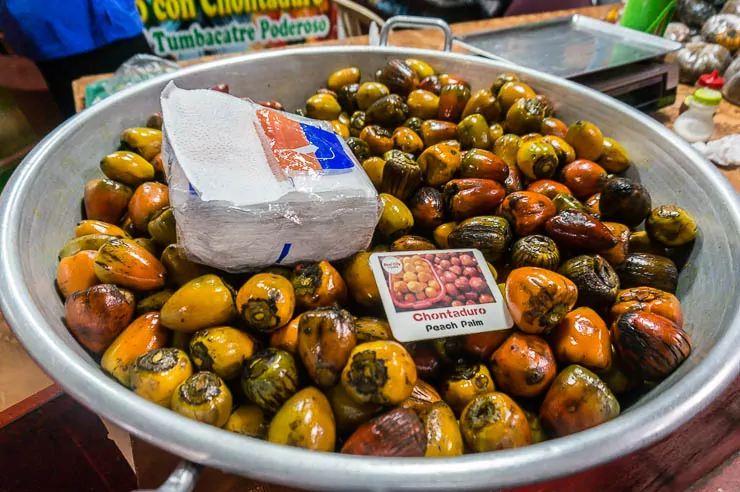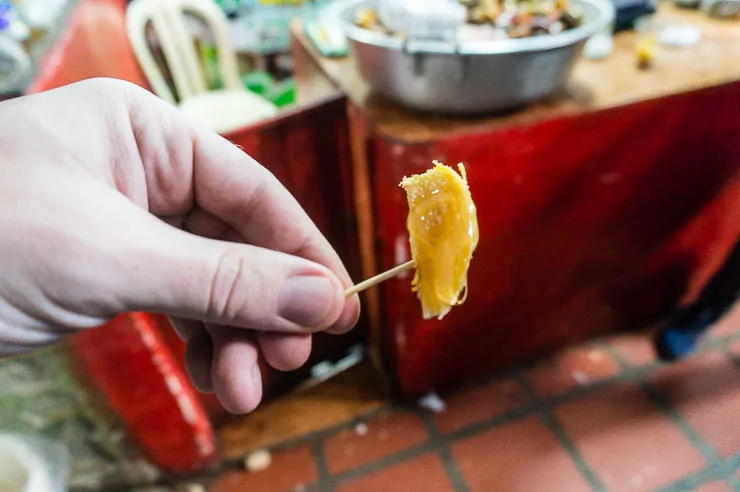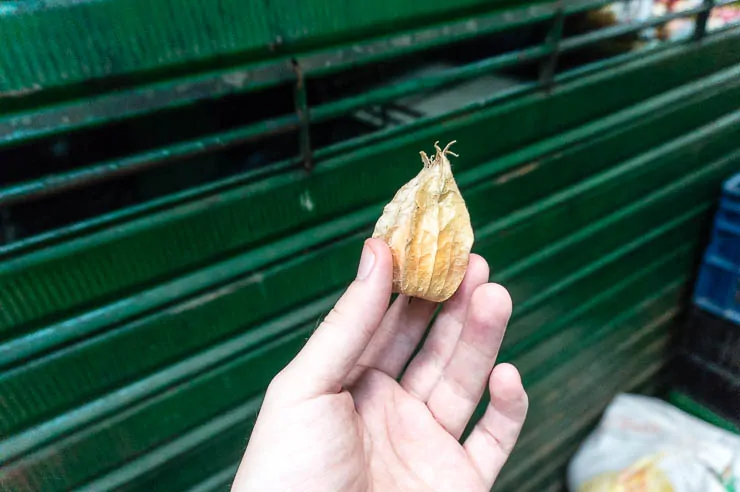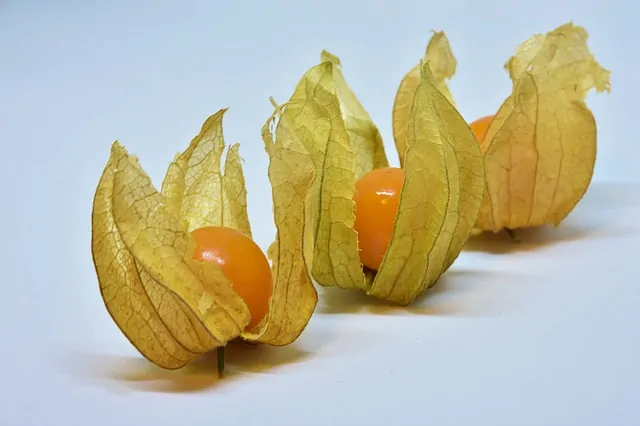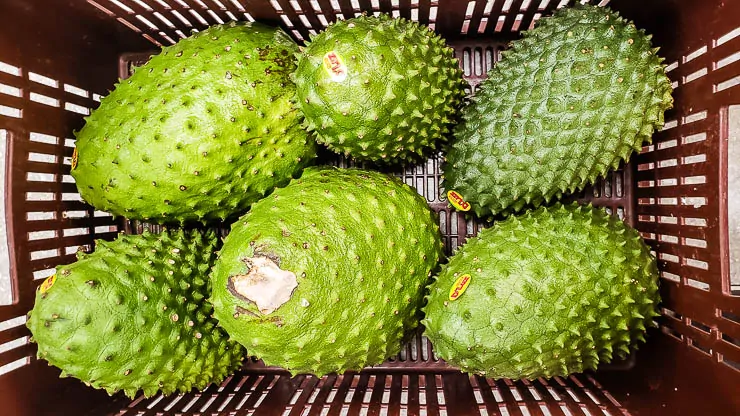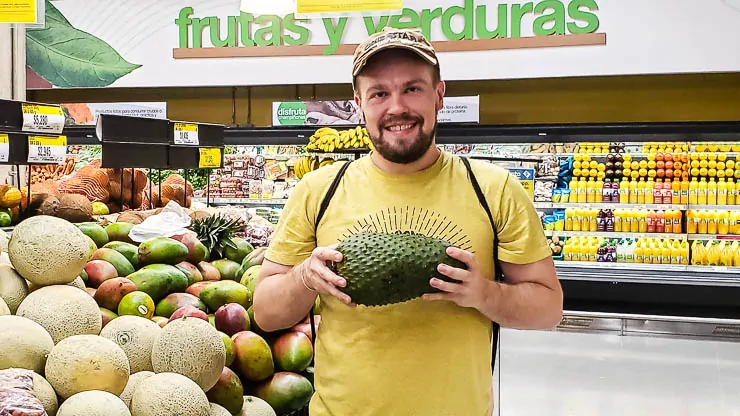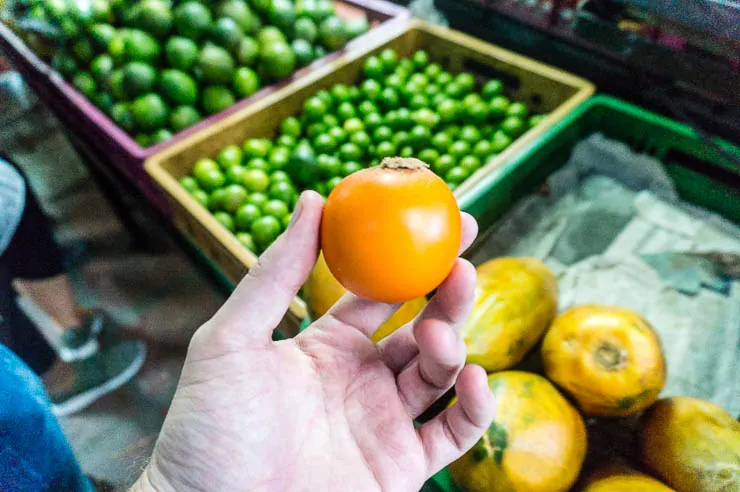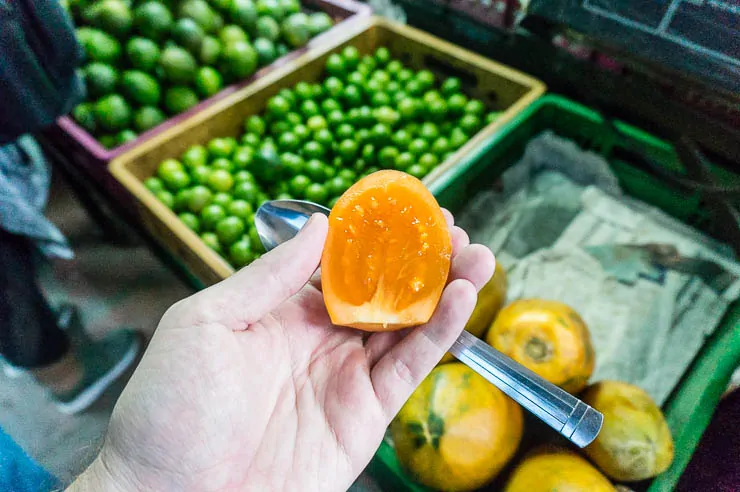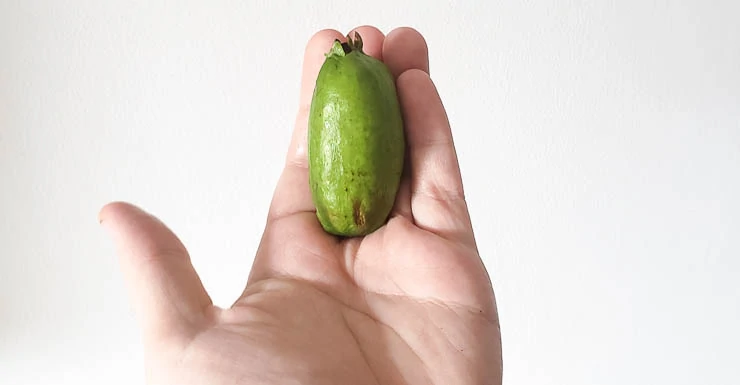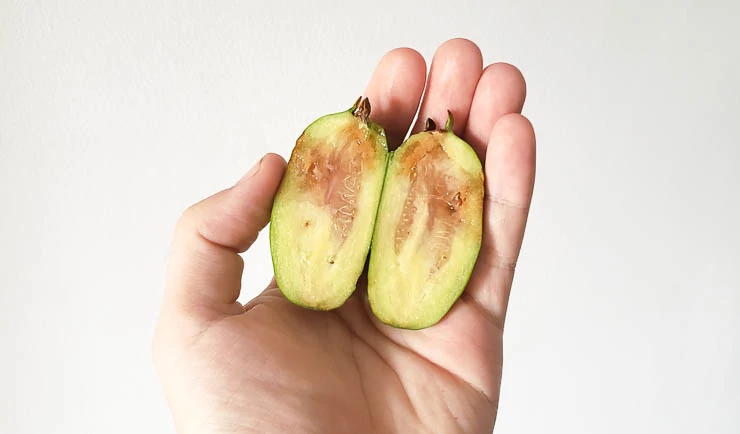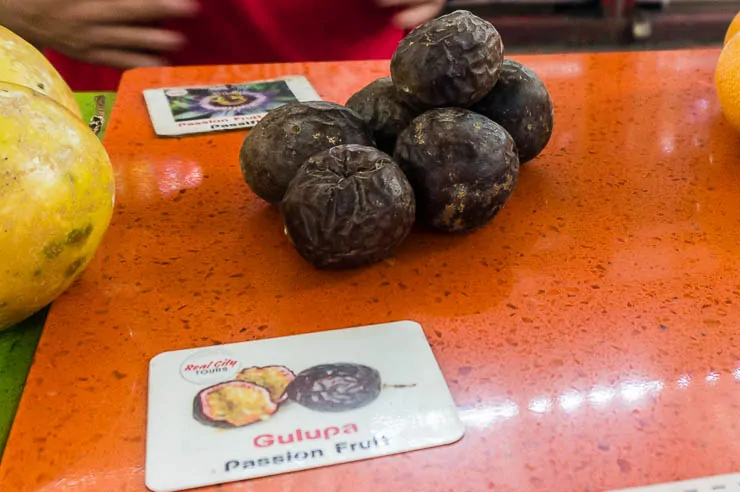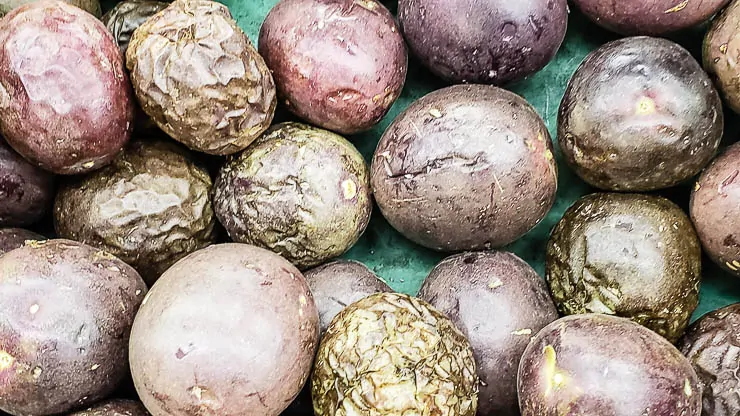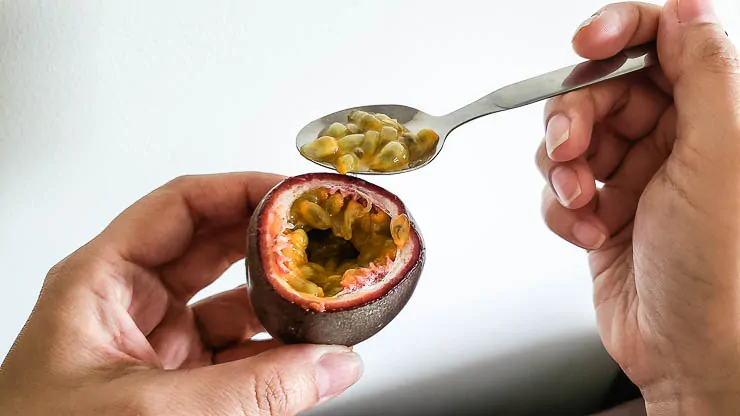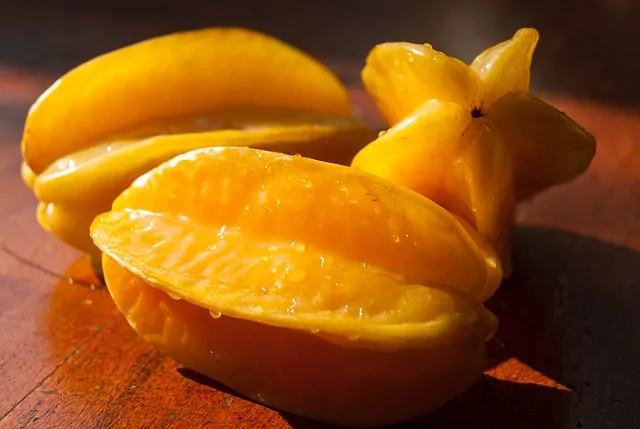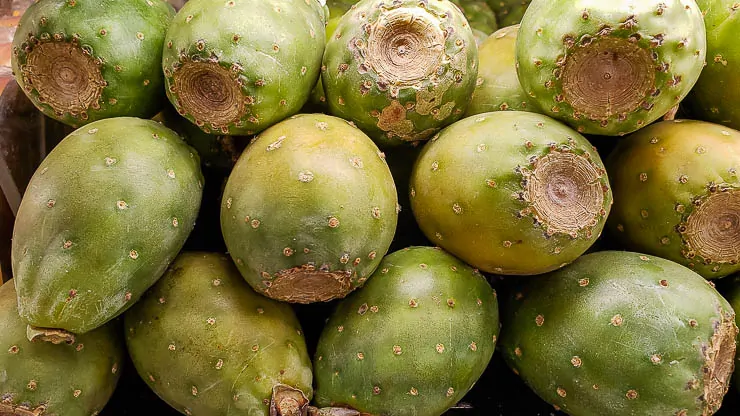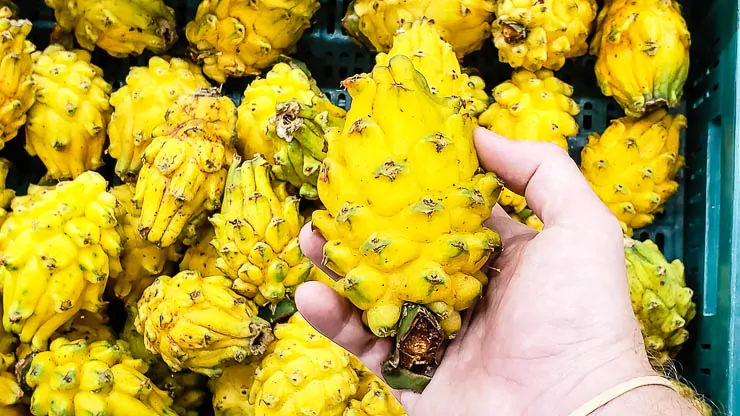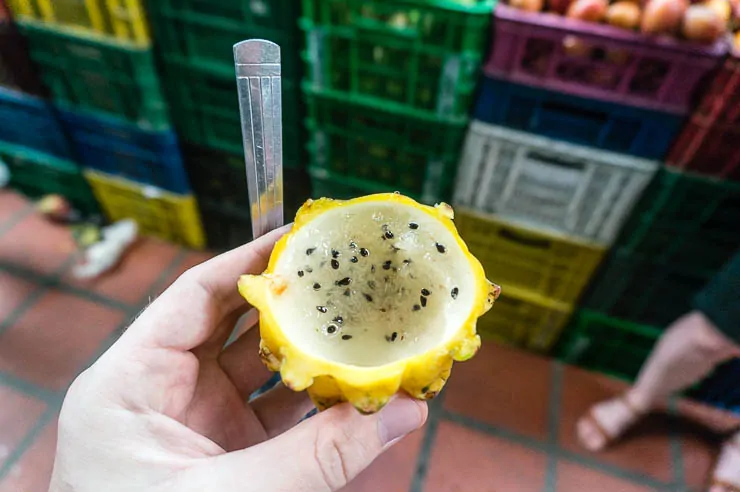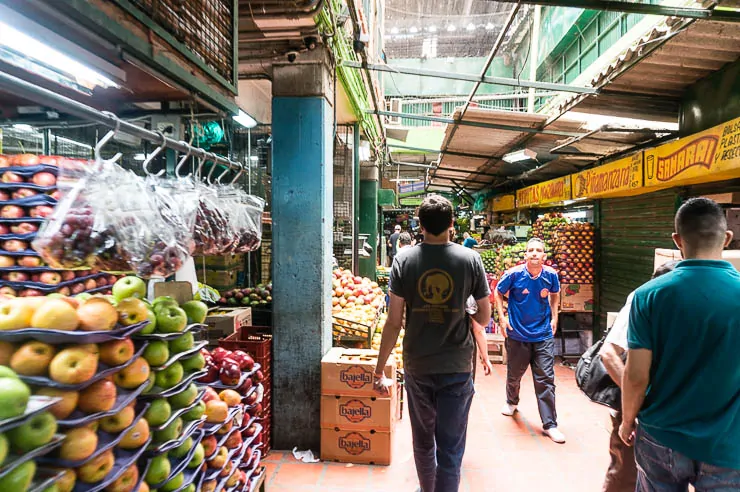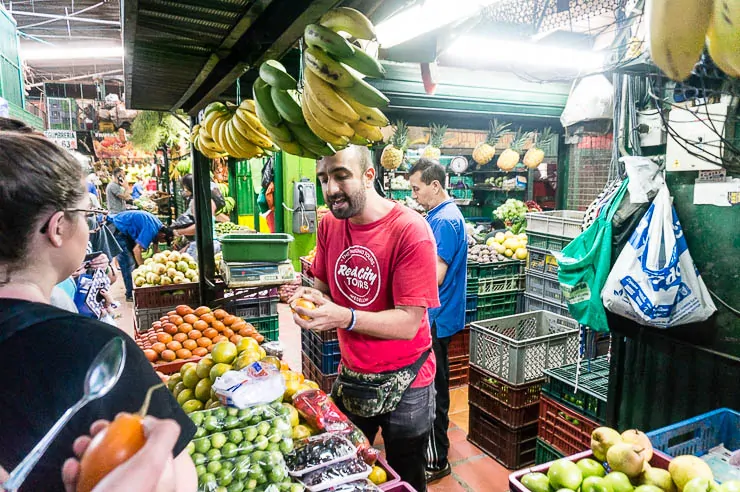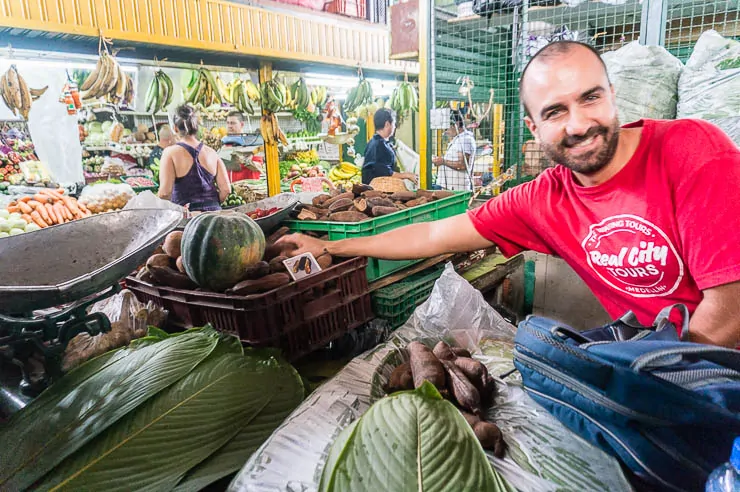Colombia is a land of superlatives and extremes, still full of poverty but so very rich in biodiversity and natural resources. One thing that immediately strikes most travelers on their first trip here is just how many incredible, delicious, colorful, and strange exotic Colombian fruits there are, whether they are sold on the streets, in the markets, or served up as a delicious juice or smoothie.
Colombia is the world’s second most biodiverse country after Brazil and is a place rich in plant and animal life with an almost mind-boggling variety. The same is true of the exotic fruits here.
Of course, there are the standard tropical fruits that you are already familiar with, like mango, pineapple, bananas, avocados (yes, actually a fruit), papaya, and more… Colombia has all those things, but also SO much more. Indeed, the sheer number of strange Colombian fruits that I’d never heard of before coming here (and those I continue to learn about after years) is quite incredible.
Exotic Colombian Fruits Tour
I’ve always enjoyed the numerous fresh tropical fruit juices which are readily served up across Colombia and consumed on a daily basis by those of us who call this country home (locals or foreigners alike). Fruits are everywhere here and an almost daily part of life… Fresh fruit juice is almost obligatory during any Colombian lunch.
I thought I’d “seen it all” after a few years here, but when I was invited on the Real City Tours exotic fruits tour in the Minorista Marketplace in El Centro, I quickly learned that that wasn’t the case. I was still missing quite a lot!
The exotic tropical fruits tour was incredibly interesting (and delicious) and is one of those Medellin tours that I’d recommend working in among the many other things to do in Medellin.
In this virtual tour of Colombian fruits, I wanted to introduce you to some of the most unusual exotic fruits we tried on the tour (as well as a few others), just to give you a better idea of the incredible opportunities that await you if you enjoy exploring new and unusual things.
After that, I’ll be sharing where the best place is to find these fruits in Medellin as well as a little more details about the exotic fruits tour.
Maracuya – Yellow Passion Fruit
Maracuya, aka the yellow passion fruit, is almost ubiquitous across much of Colombia. This is a type of citrus fruit rich in vitamin C and antioxidants. It’s almost like a hollow gourd filled with a bunch of seeds, these seeds are each covered in a slippery, juicy little bit of fruit.
It is actually the seeds covered in fruit that you eat when you are eating Maracuya. Most people slurp them whole, not chewing on the seeds. There is a whole family of passion fruits that are similar, albeit with slightly different forms, tastes, or colors. The yellow passion fruit is quite bitter or tart, but that is a taste that I love, personally. Yum!
It is quite common to find maracuya fruit juice, but they also use maracuya for different things like desserts, jams, and so forth.
We’ll be talking about a few different passion fruits throughout this article.
Murrapo – Baby Banana
The murrapo, sometimes called banano bocadillo, is basically a baby banana that you’ll see being sold all over Colombia in tight little bushels with dozens of murrapos. I had no idea there are more than 1,000 species of bananas around the world, but the murrapo is one of them.
Generally speaking, the most common bananas I eat here in Colombia are a bit sweeter than the ones we receive imported in the United States, and this little baby banana is even sweeter still.
It seems like it takes all the same sugar content of the big bananas sold here in Colombia but packs it down into a 1/3 or 1/4 of the size. The murrapos are quite delicious and should be tried.
Locals commonly eat the murrapos by rolling them in their hands to soften them up, then squeezing them and sucking out the sweet goodness, rather than peeling and eating… It’s like nature’s version of one of those Gogurt things that I remember as a kid from the 90s.
Mangostino – Mangosteen
The mangosteen is not native to Colombia, but rather Southeast Asia, although it is cultivated here now. This unique fruit, also known as the “queen of fruits” has a thick, inedible purple rind that you crack open to get to the fleshy fruit pods contained inside.
In appearance, the little white slices of delicious sweet and sour fruit look a bit like garlic cloves, but obviously taste nothing alike. This is one of the most delicious fruits I’ve tasted here in Colombia, but it isn’t really common, owing to the fact that they have a short shelf-life and are somewhat expensive compared to other fruits (especially comparing the amount of actual fruit each mangosteen contains). As a result, even many locals haven’t tried the mangosteen.
If you see it for sale, I’d highly recommend giving this delicious, sweet, and unusual fruit a try, it is something that you’re not likely to find back home.
Tomate de Arbol – Tree Tomato
I’ve drunken about a million glasses of tomate de arbol juice during my many “menu of the day” meals, but I’d actually never eaten the fruit directly. This is actually a somewhat common theme in Colombia, as they prefer to drink many of their fruits since many flavors aren’t suitable for directly eating.
These elongated, egg-shaped fruits range in color from yellow to red and can be eaten straight, although the flavor is a bit tart. These fruits are pretty ubiquitous and cheap, which is why they are used so commonly in “menu of the day” restaurants here, where they are blended with sugar and water to get rid of the tartness.
In other parts of the world, this fruit is known as tamarillo. They are becoming more popular for use in locally inspired cocktails too, which is pretty cool.
Algarroba – West Indian Locust
The algarroba isn’t actually a fruit but rather a legume, although it is considered a fruit here. It is a strange long pod that grows from the algarrobo tree. The exterior is a super hard wooden shell which must be cracked into with a hammer in order to access the edible white interior.
The first thing you’ll notice though, as you bring the fleshy part toward your mouth, is the unmistakable foul odor. Locals also name the algarroba “pecueca” which is the Colombian slang for nasty smelling feet. No, it isn’t durian, but that should still give you a good idea of how it smells.
If you can move beyond the smell, the white fleshy part is actually pretty tasty. It isn’t like out of this world delicious, but it’s definitely good. It is actually kind of dry, chalky, and sweet, dissolving in your mouth like cotton candy.
It is a pain to get into though, believe me, I’ve tried cracking into them myself. But if you wanna try a “stinky fruit” then the algarroba should be on your list. It is more commonly used in powder which can be mixed into milk as a drink or substitute for other sugars.
Guayaba – Guava
The Guayaba or guava is a fruit that can be found the world over in both the tropics and subtropics, having spread originally from Central America. The ones found in Colombia are a few inches long and rounded, with pink flesh inside and hard black seeds.
Like many fruits, you can eat the seeds as well, but the guava seeds here are particularly hard, so be careful when chewing.
The guava here is quite often used to make a sweet treat known as bocadillo de guayaba which is also known as guava paste. It is basically a block of the sticky sweet treat sometimes served with cheese. These bocadillos make for great gifts for people back home.
The fruit itself is quite sweet and delicious, just head the warning about the seeds. It is also often used for juice.
Mamoncillo – Spanish Lime
These green little balls look like smaller lime, giving them their English name of “Spanish Lime.” They’ve got a thin skin which is easily popped off with the fingernail or you can break the skin with your teeth and pop out the fruit.
Be careful, though, don’t just bite down! This fruit is actually much more seed than fruit. It contains a large seed at the center, covered by the yellowish fruit.
Basically, the mamoncillo is popped into the mouth whole to suck on for a little bit, trying to draw out as much of its flavorful juice and flesh as you can, then you just spit the large seed into the trash.
They are tasty little fruits, although you don’t get much out of each one.
Curuba – Banana Passion Fruit
The curuba is another member of the passion fruit family, but this one is smaller and more elongated, rather than round, thus giving it the “banana” name in English. This one is also a bit tart, though in my mind less-so than the maracuya, with seeds that are perhaps a little more bitter.
Curuba is often used to make a milk-based drink which helps knock down some of the tartness, resulting in a fruity milkshake sort of concoction. It is quite good, but of the four passion fruits we’ll be discussing, it stands out as the least notable, to me.
Borojo
Borojo is perhaps one of the most unusual fruits on the list. This fruit can only be found the Choco Province of Colombia (and Esmeraldas in Ecuador) where it grows in conditions of high heat and humidity.
You’re likely to only see it neatly wrapped in plastic in a mesh bag where this delicate fruit will actually rot a little bit. Yeah, it doesn’t sound or look appetizing whatsoever, and it is apparently very bitter when eaten alone.
This isn’t a common fruit, but we had it as a drink where it was mixed with milk and sugar, basically creating a big ol’ delicious milkshake. It’s honestly like an ice cream smoothie, surprisingly yummy, and a must-try! They also say that it is an aphrodisiac, haha.
Guama – Ice Cream Bean
This interesting looking fruit is like a giant bean pod growing on the trees and it is indigenous to South America. When you crack open the bean pod, you’ll find a series of white fleshy bulbs inside, each one covering a hard seed.
There isn’t much flesh to each seed, but the flavor has been compared to vanilla ice cream albeit not so sweet. This is certainly an unusual fruit that you should try and seek out when you’re here.
Zapote or Sapote
This is another unusual fruit that is about the size of a large apple but shaped like a spinning top. Outside is hard and brownish and it is native to the Amazon region. The easiest way inside is to pop off the stem piece and then peel the hard flesh down from the hole it leaves. Inside is a bright orange, fibrous fruit covering about 4-5 large seeds inside.
Like the mamoncillo, the easiest way is to just pop the seed and fruit inside your mouth to suck on the juice and try to remove as much of the flesh as possible. You can’t actually get all the fibers off the seed since they are stuck very well to the seed, but you can get almost all the juice out.
It is actually a very nice fruit that you should try and seek out in a local market. Fair warning though, these fruits seem to have an unusually high occurrence of worms inside, so you must always carefully check over the fruit inside before eating.
Granadilla
The granadilla is another member of the passion fruit family, with a light orange or yellow exterior, and about the size of an orange, as well. You’ll also easily recognize it by the stem. You can crack into the rigid but weak exterior of the fruit with your hands, and inside you’ll find purplish colored seeds covered in that fleshy material.
This was the first of the passion fruits I ever tried, and it is much more commonly sold whole like this and easy to find on the streets. Indeed, it makes a quick and easy on-the-go snack for locals.
The flavor is not tart like some of the others, and while it is sweet, it isn’t overwhelmingly so. Compared to the other members of the family, it is a milder flavor, more suited to eating whole rather than in juice form.
As a side note, did you know the passion fruits are named that way not because of any sort of love or romantic passion, but rather for the passion of the Christ? The flowers of this plant are unbelievable — seriously, I’ve never seen anything like them.
They were named so because these flowers supposedly are representative of the Passion with elements like the ten apostles in the ten petals, the crown of thorns, and other religious elements. Supposedly the Spanish priests used these flowers to help proselytize to the locals about Christianity.
Chontaduro – Peach Palm
The chontaduro is a different sort of fruit in that these small reddish to yellowish berry looking things are not actually eaten fresh. The tough texture of them requires them to be boiled for hours in order to soften up the skin and make them edible.
They aren’t very sweet, and the fruit has more of a fleshy texture and a flavor that I found reminiscent of sweet potatoes. It’s an okay fruit, but not exactly at the top of my list of favorites. Locals will often drizzle honey over them to make them a little sweeter and more delicious.
Uchuva – Cape Gooseberry
The uchuva is a small fruit about the size of a cherry, but each fruit comes “wrapped” in a nifty little papery leaf package. You rip off the leafy exterior and find the little yellowish fruit contained inside.
They don’t have any hard seeds so you can just pop it your mouth whole. This is another fruit that is a bit sweet or tart, so it isn’t among the favorites, although some locals will use the uchuva as a chaser after shots of aguardiente (the local firewater).
The fruit contains properties that supposedly good for the eyes and prostate as well. I quite like the little fruits, although they have a tendency to get overripe and soften quite quickly, so you should plan to eat them fast. You can also find them sold without the papery leaf covering.
Guanabana – Soursop
This fruit is a monster — not only is each fruit massive but the exterior is green and spiky, like something straight out of Jurassic Park. Honestly, these fruits are almost too big to buy individually, which is why you’ll often see them split open and sold in halves or quarters.
You’ll recognize it for its slimy white interior. It doesn’t look too appetizing at first glance, and the fruit itself has a lot of large black seeds which can make for quite a lot of work.
There is a lot of fruit here, and most often in Colombia, they use the guanabana for juice. The white juice is sweet and refreshing and is actually the only way I’ve consumed it. I’ve yet to try the fruit in its whole form, simply for the reasons we talked about above.
Cherimoya – Custard Apple
Cherimoya is a relative of the guanabana, but thankfully it is much smaller than its monster-sized cousin. Rather than spikes, this smaller green fruit has a scaly or textured surface. It is also white on the inside with large black seeds like the guanabana, but it contains much less of the seeds.
The fruit has a creamy texture, not quite as juicy, and which led to its name of “custard apple” in English. This is a really good fruit and a whole lot more manageable than the guanabana if you’re looking to try it in the fresh fruit form rather than juice.
Lulo – Little Orange
This sour little fruit is most commonly used in juices and can be found quite readily, although perhaps not quite as common as maracuya or tomate de arbol. The lulo is actually part of the same family as tomate de arbol (the nightshade) and is not commonly eaten on its own due to the sour factor.
I’m a fan of sour fruits though, so I quite enjoy eating it on its own. If I had to compare it to a more common fruit, I’d say it is fairly similar to the kiwi with a bit of a citrus flavor. It also has soft seeds inside like the kiwi which are edible. I quite like lulo, both as a fruit and in the juice form.
Feijoa – Guavasteen
The feijoa is a small green little oblong fruit that looks a bit like a tiny cucumber. Inside is white flesh with a translucent center, a bit reminiscent of cucumber as well. This one you don’t normally eat the skin because of the bitter flavor, but rather just scoop out the middle with a spoon to enjoy.
It has a strong and pleasant smell and the taste and texture are a bit like a pear, in my mind, with that sort of slightly gritty texture as well. It’s a really delicious fruit that you must try!
You’ll know the fruit is ripe if you cut it open and there is a larger transparent area in the middle. If it is all white, it is not ripe enough, and if it is starting to go brownish, that means it is overripe (which some people prefer).
Gulupa – Purple Passion Fruit
Here’s another one of the passion fruit family members, the gulupa. This one is known as the purple passion fruit because of its outside color. The exterior of the fruit often turns a bit dimpled or wrinkly too… From the outside, it isn’t a particularly attractive fruit.
On the inside, you’ll find the same fleshy seeds as all the other passion fruits, but the flavor of the gulupa is much sweeter, less tart, and probably the most delicious of the four.
This one is a favorite of many people, although it is nowhere near as common as the granadilla and maracuya. I’d highly recommend trying the gulupa at some point in your travels in Colombia! The more wrinkly, the better in terms of sweetness.
Carambola – Star Fruit
This attractive-looking fruit forms beautiful little stars when cut into slices. You’ll often find them tossed into fruit salads or used as garnishes on drinks. It’s a good fruit, but it’s also kind of plain, not really too sweet or overwhelmingly delicious.
These fruits aren’t really anything to write home about, in my opinion, but they are certainly nice looking though! 🙂
Higo – Prickly Pear
I first got to know this delicious cactus fruit in Mexico where they call it “tuna”. The most common type you’ll find is a oblong green one. The easiest way to eat them is to chop off both ends of the fruit, then make a slit across the body which can then be peeled away from the fruit.
These higos are surprisingly juicy, especially given the fact that they come from a cactus. Sometimes they are practically dripping with fruit juice. I quite like higo and you’ll also find them in a few different colors like red and yellow, although green is the most common here.
Be careful with the outside of the fruit, there may be spines (since it is from a cactus) although that is pretty uncommon. In English, it is also known as a cactus fig.
Pitahaya – Dragon Fruit
The pitahaya, also known as dragon fruit, is a spiky yellow fruit on the outside and features a beautiful, juicy white flesh filled with small black seeds on the inside. This is a fruit that you can find around the world in tropical locales, although in different colors. Here in Colombia, it is the yellow dragon fruit that reigns supreme, rather than pink or red colors of Asia.
This fruit is another cactus fruit, like the higo above, but is probably even more delicious, at least for my palate. You can cut open the pitahaya and just scoop out the juicy white flesh and eat it right along with the seeds.
Be warned though, pitahaya is renowned for helping digestion, so everyone warns against eating too much of this delicious fruit.
Even More Exotic Colombian Fruits
So that’s just a brief tour of some of the most unusual and noteworthy fruits of Colombia among those that I have tried personally. I’ve eaten almost all of them in their whole, fresh form, and a couple only in juice form (like guanabana and borojo). I’d recommend trying as many of these fruits as you can during your time here, and I’ll actually give you a couple recs for how to do so, just momentarily.
Even though I’ve tried a lot of the most exotic Colombian fruits, there are still quite a few that I have yet to taste, if you can believe it! There is truly a smorgasbord of fruit options here in Colombia, which could keep you busy for quite a while…
I was talking with locals here in Colombia about some more fruits and they mentioned things like chonta, nispero, corozo, papayuela, granada, annona, mortiño, and noni/morinda, just to name a few more that I haven’t tried and didn’t talk about here.
Where to Taste These Colombian Fruits
The best place to taste any of these fruits is in one of the major Colombian cities in the biggest local market. In the city of Medellin, that market would obviously be Minorista in El Centro where you can find basically anything and everything — it goes well beyond fruits and vegetables, to meats, cheeses, consumer goods, and even live animals.
The Minorista is one of those must-do things in Medellin, in my book. And while I’ve visited the market a number of times on my own, I gotta a lot more out of the experience by going with a knowledgeable guide as I finally did with Real City Tours.
I’ve been introduced to a lot of local fruits thanks to ties to locals here, but obviously, even their knowledge about the sheer range of fruits pales in comparison to a guide. You can pack in more fruits in a few hours on a tour than you probably otherwise would in weeks… I’d highly recommend it!
Real City Tours Exotic Fruits Tour
The Real City Tours Exotic Fruits Tour runs daily at the Minorista Market, so long as they have the minimum number of participants, and it takes about three hours. You’ll have to meet up at the Metroplus station outside the market (it connects with the Metro system) where you’ll head out with your guide through the labyrinth that is La Minorista.
The tour costs less than $20 and includes everything — we had 14 different exotic fruits, a bit of arepa de choclo with fresh queso, and even a fresh fruit smoothie or juice at the end (where I tried the borojo). I even got to try the super tiny pajarito pepper, which is also super hot — be warned!
Honestly, it is a fantastic deal and makes for a fun half-day out in Medellin where you can learn more about some of what this country has to offer.
Real City Tours is also the operator behind the amazing Medellin free walking tour (my #1 recommended activity) and the barrio transformation tour (different and better than Comuna 13) in Moravia Medellin. No, they aren’t paying me, I’m just happy to recommend fun and awesome activities to make your trip to Medellin as memorable and enjoyable as possible.
You can reserve your exotic Colombian fruits tour now on the Real City Tours website.
Planning Your Trip to Medellin
Traveling to Medellin soon? Book your lodging now via Booking.com to save, and be sure to check my travel guide about where to stay in Medellin, including the best Medellin hostels, or my ultimate guide of things to do in Medellin to plan an unforgettable trip. If you’re traveling throughout Colombia, don’t miss my detailed guide to traveling to Colombia.
Read Next: Ultimate Guide to Colombian Food
Travel Insurance for Medellin
Finally, don’t forget to purchase travel insurance for Colombia to protect yourself against theft, sickness, and injury while in Medellín. I use and recommend World Nomads for the best combination of affordability and coverage.
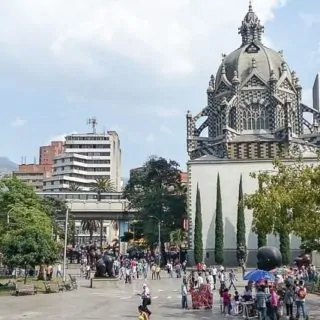
Colombia Travel Tips
Important tips and resources for planning an amazing trip to Colombia, based on my years of traveling and living in Colombia.
Tools
Colombia Trip Planning
Instructions
- Book a cheap flight to Colombia with Momondo, or better yet, start travel hacking so you can fly for free. Traveling between major cities is much better by flying, trust me.
- Plan a rough itinerary and how long you will spend at each destination. Use an itinerary planning service for custom recommendations and pick up Lonely Planet Colombia.
- Work a little every day to teach yourself Spanish, you'll want to know as much as possible before you arrive.
- Book cheap accommodation in advance, at least for the first destinations -- For hostels use: Booking, for cheap hotels use: Hotels.com, for apartments use: Airbnb.
- Reserve your on the ground tours and activities through Get Your Guide.
- Purchase travel insurance for Colombia with SafetyWing to protect yourself from illness, injury, and theft while in Colombia. VERY important. And be sure to read my article: "Is Colombia Safe?" for my honest opinion and safety tips.
- Sign up for my free emails about planning a better trip to Colombia, and be sure to check out my comprehensive guide about traveling to Colombia.
- Learn more money-saving tricks with my top budget travel tips.
- Put together your Colombia packing list.
- Enjoy this incredible country!
Notes
I hope this helped you plan your travels in Colombia! I know it can be a struggle to find accurate and on the ground information when traveling to a new place like Colombia, which is why I started writing so extensively about it!
If you have any questions about Colombia, budget travel, or anything else shoot me an email at ryan@desktodirtbag.com.
(I love getting questions! That is how I get ideas for my blog posts and what to write about!)
Recommended Products
As an Amazon Associate and member of other affiliate programs, I earn from qualifying purchases.
Share This
Did you enjoy this post about exotic Colombian fruits? Please take a second to share it on Pinterest, Facebook, or Twitter. Thanks!
Ryan
Latest posts by Ryan (see all)
- Kazakhstan Food: Exploring Some of its Most Delicious Dishes - August 7, 2023
- A Self-Guided Tour of Kennedy Space Center: 1-Day Itinerary - August 2, 2022
- Fairfield by Marriott Medellin Sabaneta: Affordable and Upscale - July 25, 2022
- One of the Coolest Places to Stay in Clarksdale MS: Travelers Hotel - June 14, 2022
- Space 220 Restaurant: Out-of-This-World Dining at Disney’s EPCOT - May 31, 2022

